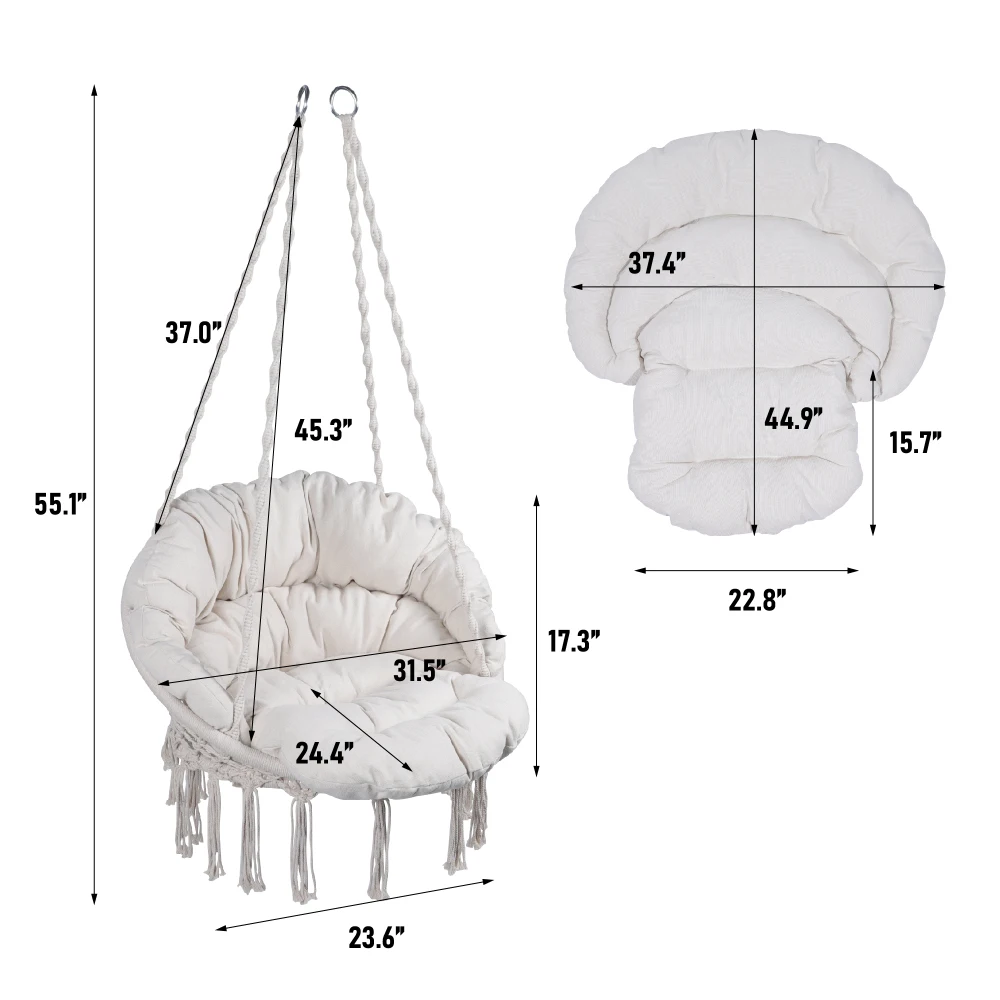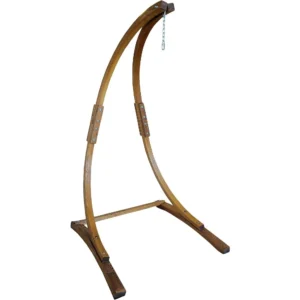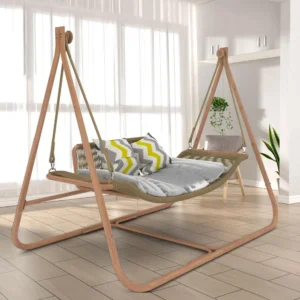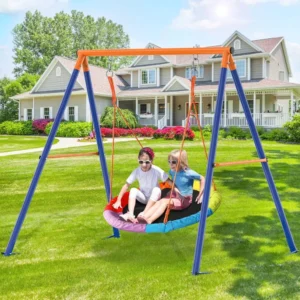Introduction: Transforming Your Covered Porch with a Hammock Chair
Imagine yourself gently swaying in the breeze, a good book in hand, as you relax in your hammock chair on a covered porch. The gentle rocking motion soothes away stress while you remain perfectly sheltered from direct sun and unexpected rain showers. This isn’t just furniture—it’s an experience that transforms your covered porch into a personal retreat.
Hammock chairs offer unique advantages for covered porches that traditional furniture simply can’t match. Unlike full-sized hammocks that demand significant space, these versatile chairs provide the same relaxing sway in a compact footprint. The protected environment of a covered porch creates the perfect setting for year-round enjoyment, extending the lifespan of your chair while offering shelter from harsh weather.
From macramé-styled bohemian designs to sleek modern egg chairs with stands, hammock chairs come in numerous styles to complement any porch aesthetic. Whether you’re seeking a reading nook, a conversation piece, or simply a spot to unwind after a long day, a well-chosen hammock chair can become the centerpiece of your covered outdoor space.
In this guide, we’ll walk you through everything you need to know about selecting, installing, styling, and maintaining the perfect hammock chair for your covered porch. Whether you’re a homeowner looking to enhance your existing space or someone designing a new porch retreat, you’ll discover how these versatile seating options can transform that in-between space where indoor comfort meets outdoor living.
The perfect hammock chair does more than just provide a place to sit—it creates hammock chair ideas for ultimate relaxation that can change how you experience your home.
Why Hammock Chairs Are Perfect for Your Covered Porch
Hammock chairs offer numerous advantages that make them ideal additions to covered porches. These benefits extend beyond simple seating options:
Space Efficiency
Unlike traditional hammocks that require two distant anchor points, hammock chairs need only a single mounting point or a compact stand. This space-saving design makes them perfect for porches of all sizes, especially smaller ones where space is at a premium. Even a modest 4×6 foot corner can accommodate a hammock chair and still leave room for movement.
Versatility
Hammock chairs can be positioned in corners, centered as focal points, or arranged to create intimate conversation areas. Their flexibility allows you to experiment with different layouts as your needs change. Many models can be easily moved or repositioned, giving you freedom to refresh your porch design seasonally.
Protected Environment Benefits
Your covered porch provides significant protection from direct elements, extending the lifespan of your hammock chair compared to fully exposed outdoor furniture. The roof shields from harsh UV rays, direct rainfall, and debris, while still allowing you to enjoy fresh air and outdoor ambiance. This sheltered setting means you can often choose from a wider range of materials than you would for fully exposed outdoor furniture.
Comfort Advantages
The gentle swinging motion of hammock chairs provides unique comfort benefits:
– Natural stress reduction through gentle movement
– Ergonomic support that contours to your body
– Cocooning effect that creates a sense of security
– Improved circulation from the elevated seated position
Studies have shown that gentle rocking motions can reduce stress hormones and promote relaxation—making hammock chairs not just comfortable but therapeutically beneficial.
Aesthetic Appeal
A well-chosen hammock chair instantly elevates your porch’s visual interest. Whether it’s a handcrafted macramé design adding bohemian charm or a sleek modern egg chair creating contemporary appeal, hammock chairs serve as both functional seating and artistic statement pieces that express your personal style.
The inspiring covered porch hammock chair options available today range from rustic to refined, ensuring there’s a perfect match for any architectural style or design preference.
Year-Round Usability
Unlike open patio furniture that might be unusable during inclement weather, a hammock chair on a covered porch remains accessible nearly year-round. Add a warm throw blanket for cooler seasons, and you’ve created an outdoor retreat that serves you through changing weather. This extended usability makes hammock chairs an excellent investment in your home’s livable space.
Browse our selection of hammock chairs with stands designed specifically for covered porch environments to find the perfect addition to your home.
Types of Hammock Chairs for Covered Porches
Hanging Hammock Chairs (Ceiling-Mounted)
Ceiling-mounted hammock chairs create a true floating appearance that maximizes both visual appeal and swinging motion. These chairs attach to your porch ceiling with specialized mounting hardware, creating an unobstructed swinging experience.
Macramé Styles
Macramé hammock chairs feature intricate handwoven patterns created from cotton or synthetic rope. These bohemian-inspired designs offer:
– Distinctive artisanal patterns that create visual texture
– Open-weave designs that allow for airflow on warmer days
– Lightweight construction that appears to float in the space
– Handcrafted appearance that adds artistic value to your porch
Fabric Hammock Chairs
Fabric models use durable canvas, polyester, or cotton blends stretched across supportive frames. These chairs offer:
– Greater seat stability than open-weave designs
– More weather-resistant options (especially in polyester varieties)
– Wide color and pattern selections to match your decor
– Often higher weight capacities than rope-only designs
Egg or Pod Designs
These enclosed or semi-enclosed chairs create a cocooning effect that many users find exceptionally comforting:
– Curved sides that provide a sense of privacy and security
– Often more substantial cushioning for extended comfort
– Statement-making silhouettes that become focal points
– Enhanced wind protection for cooler days
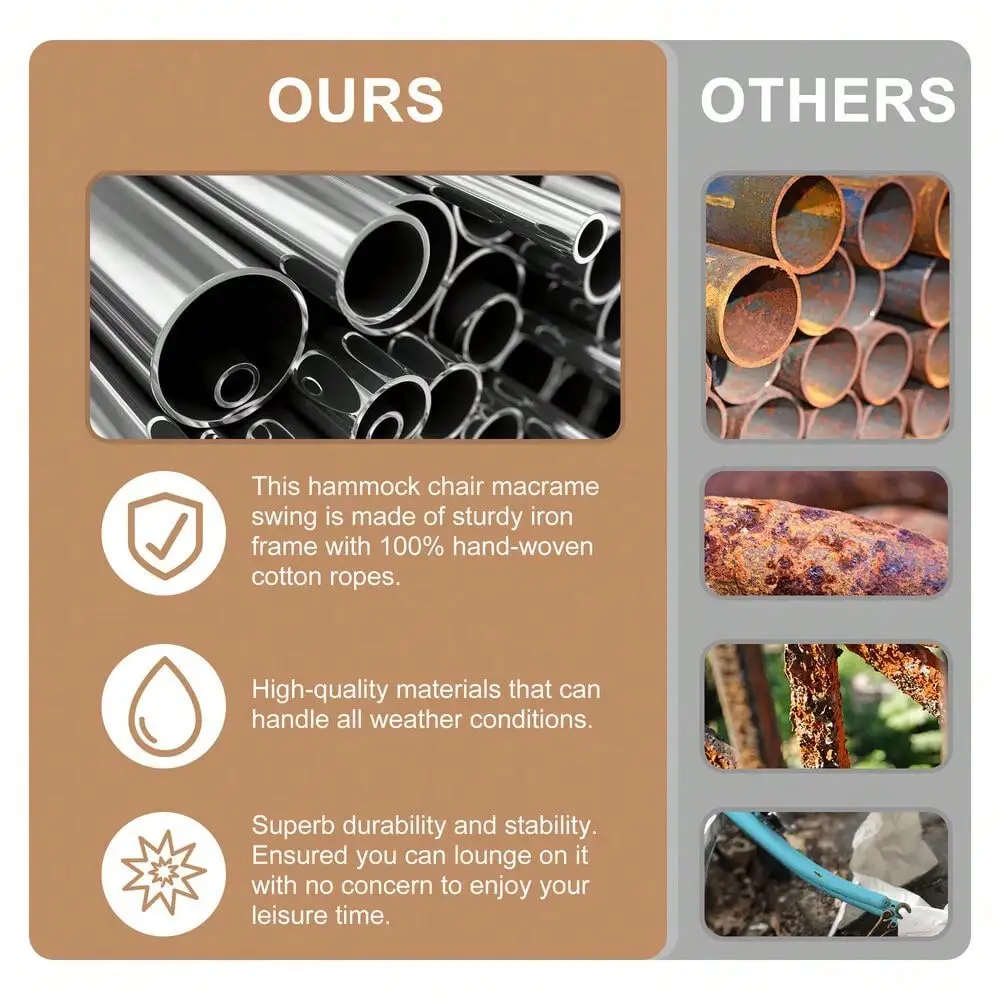
If you’re exploring options, understanding the different names for hanging seats can help you navigate the various styles and designs available.
Pros of Ceiling-Mounted Chairs:
– Space-efficient with minimal footprint
– Full range of swinging motion
– Visually striking floating appearance
– Often more affordable than stand models
Cons of Ceiling-Mounted Chairs:
– Require proper structural support for safe installation
– Less portable than stand models
– Installation process more complex
– May not be suitable for rental properties with restrictions
Our swinging hammock chair sets provide everything you need for a complete ceiling-mounted setup.
Hammock Chairs with Stands
Stand-based hammock chairs offer the perfect solution when ceiling mounting isn’t feasible or when you prefer the flexibility of repositioning your chair.
C-Stand Models
These space-efficient stands feature a curved design that positions the base under your seating area:
– Smaller footprint than traditional stands
– Stable design that prevents tipping
– Often made from powder-coated steel for durability
– Height typically between 6-7.5 feet tall
Traditional Frame Stands
These freestanding structures provide sturdy support with a wider base:
– Maximum stability for higher weight capacities
– Often constructed from steel, aluminum, or wood
– Some models accommodate multiple hanging positions
– Typically require more floor space than C-stands
Portable/Folding Options
For maximum flexibility, especially during changing seasons:
– Collapsible designs for easy storage
– Lightweight materials for repositioning
– Tool-free assembly for quick setup
– Ideal for transitioning between indoor and outdoor use
Pros of Stand-Based Chairs:
– No installation required
– Can be moved or repositioned as needed
– No structural requirements or modifications to your home
– Suitable for rental properties with restrictions
Cons of Stand-Based Chairs:
– Larger footprint than ceiling-mounted options
– Potentially limited swing range
– Additional cost for the stand component
– Some models less stable than ceiling mounts
Our collection of hanging egg chair sets includes many stand-based options perfect for covered porches.
Swing Chairs & Hybrid Models
Swing chairs represent a middle ground between traditional porch swings and hammock chairs:
– More structured frame than typical hammock chairs
– Often feature armrests and defined seating areas
– Suspended from two points rather than one
– May offer more stable seating for those uncomfortable with the full hammock experience
These hybrid designs are ideal when you want:
– Greater stability with less pronounced swinging motion
– More defined seating position
– Easier entry and exit for users with mobility concerns
– The aesthetic of a traditional porch swing in a more compact footprint
Explore our porch swing chair sets for options that balance hammock comfort with swing stability.
Materials and Durability for Covered Porch Environments
Understanding Covered Porch Conditions
While covered porches provide significant protection, they still present unique environmental challenges for furniture:
Indirect Weathering Factors
– Humidity and ambient moisture that can foster mold growth
– Reflected UV rays that can gradually fade fabrics
– Wind-driven rain that may reach furniture during storms
– Temperature fluctuations that can stress materials over time
Seasonal Challenges
– Spring pollen that accumulates on surfaces
– Summer humidity that can affect fabric tension
– Fall debris that may stain or damage fabrics
– Winter cold that can make some materials brittle
Understanding these factors helps you select materials that will perform well in your specific porch environment. The right material choices can mean the difference between a hammock chair that lasts for many years versus one that requires replacement after just a few seasons.
For more specific information about protection from the elements, explore our guide to weather-resistant hammock chairs for porches.
Fabric Options Evaluated
Solution-Dyed Acrylics
Premium fabrics like Sunbrella represent the gold standard for outdoor applications:
– Color integrated throughout the fiber (not just surface dyed)
– Exceptional UV resistance with minimal fading
– Mildew resistant and quick-drying properties
– Typically 5+ years of performance in covered settings
– Higher initial cost but superior long-term value
Polyester Blends
These mid-range fabrics offer good performance at moderate price points:
– Good color retention with moderate UV resistance
– Water-resistant properties that repel light moisture
– Generally easy to clean with mild soap and water
– 3-5 year typical lifespan in covered environments
– Wide range of colors and patterns available
Cotton and Natural Fibers
These traditional materials offer exceptional comfort but require more care:
– Superior breathability for hot climates
– Soft texture against skin
– Natural appearance that blends with organic decor
– Require more frequent cleaning and maintenance
– 2-3 year lifespan without special treatments
– May need to be brought indoors during extended damp periods
Olefin/Polypropylene
These synthetic materials excel in moisture resistance:
– Extremely quick-drying properties
– Highly resistant to mold and mildew
– Good colorfastness at lower price points
– Lightweight but durable construction
– 3-4 year typical performance in covered areas
For a comprehensive analysis of material options, visit our guide on best materials for hammock chairs on porches.
Support Materials and Hardware
Rope Types
– Polyester: Excellent UV and water resistance, minimal stretching
– Cotton: Superior comfort but requires more maintenance
– Nylon: High strength but can degrade with UV exposure
– Polypropylene: Good moisture resistance, moderate UV stability
Hardware Options
– Stainless steel: Best overall durability, minimal maintenance
– Powder-coated steel: Good protection if coating remains intact
– Galvanized hardware: Cost-effective but may show zinc patina over time
Wood Components
– Teak and cedar: Natural oils provide excellent weather resistance
– Oak and maple: Strong but require protective finishes
– Bamboo: Sustainable option with good strength-to-weight ratio
Even in covered areas, using rust-resistant hardware is crucial. The ambient humidity on a porch can still cause corrosion in substandard metals, potentially creating safety hazards over time.
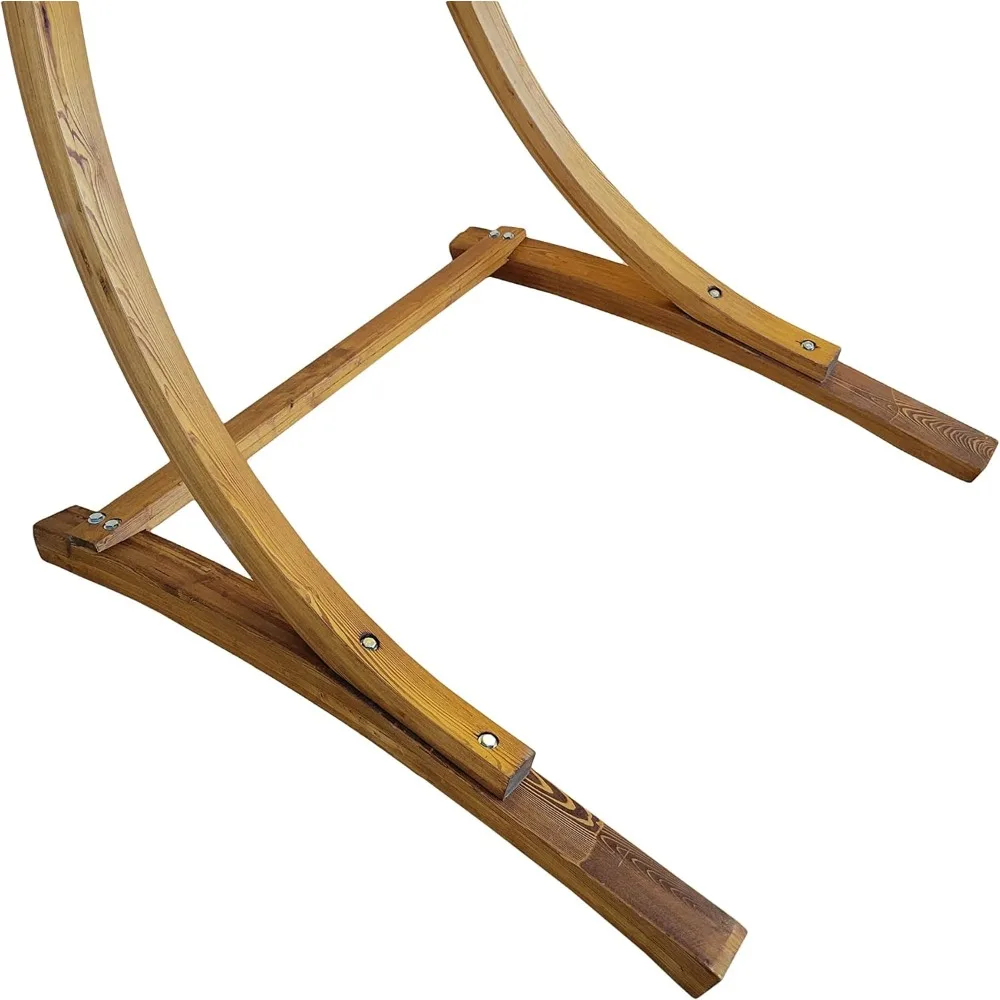
How to Choose the Perfect Hammock Chair for Your Covered Porch
Space Planning & Measurement Guide
Proper measurements prevent disappointment and ensure your hammock chair fits perfectly in your covered porch:
- Measure ceiling height from floor to attachment point (minimum 7.5 feet recommended)
- Determine swing radius (typically 3-4 feet in all directions)
- Calculate clearance needs (minimum 2 feet from walls and furniture)
- Consider entry/exit space (additional 2 feet for comfortable access)
For smaller porches, consider:
– Corner placement to maximize open floor area
– C-stand models with smaller footprints
– Chairs designed with more vertical than horizontal space requirements
– Models with controlled swing radius
Visual balance is also important—place your hammock chair where it creates harmony with existing furniture rather than appearing crowded or isolated.
For practical advice on working with height constraints, see our guide on setup tips for hammock chairs under roofed areas.
Weight Capacity & Structural Considerations
Safety should always be your primary concern when selecting a hammock chair:
Understanding Weight Ratings
– Manufacturer ratings typically include a safety margin
– Static weight capacity differs from dynamic (moving) capacity
– Always choose a capacity at least 50-75 pounds above your needs
– Consider all potential users when evaluating weight limits
Structural Evaluation
For hanging models:
– Identify ceiling joists or support beams (never attach to just ceiling drywall)
– Verify joist dimensions (minimum 2×6 inches for standard chairs)
– Consider consulting a structural engineer for uncertainty
– Use appropriate mounting hardware rated for at least 600 pounds
For stand models:
– Check base width (wider bases generally provide more stability)
– Verify leg construction (look for reinforced joints)
– Consider weight distribution and center of gravity
– Test stability before full use
For detailed information about weight considerations, see our articles on how much weight hammock chairs can hold and hammock weight capacity guidelines.
Comfort Features to Prioritize
Comfort factors that significantly impact your experience include:
Dimensional Considerations
– Seat width: 24-36 inches provides comfortable hip room
– Depth: 20-30 inches allows for different sitting positions
– Back height: Higher backs provide better head/neck support
– Entry height: Lower entry points make access easier
Cushioning Options
– Built-in padding thickness (2-4 inches optimal for extended use)
– Removable cushions for cleaning and customization
– Memory foam vs. polyester fill (tradeoffs in comfort vs. moisture resistance)
– Weather-resistant cushion covers for longevity
Ergonomic Design Elements
– Lumbar support curvature
– Armrest positioning and padding
– Head/neck support options
– Foot support or included footrests
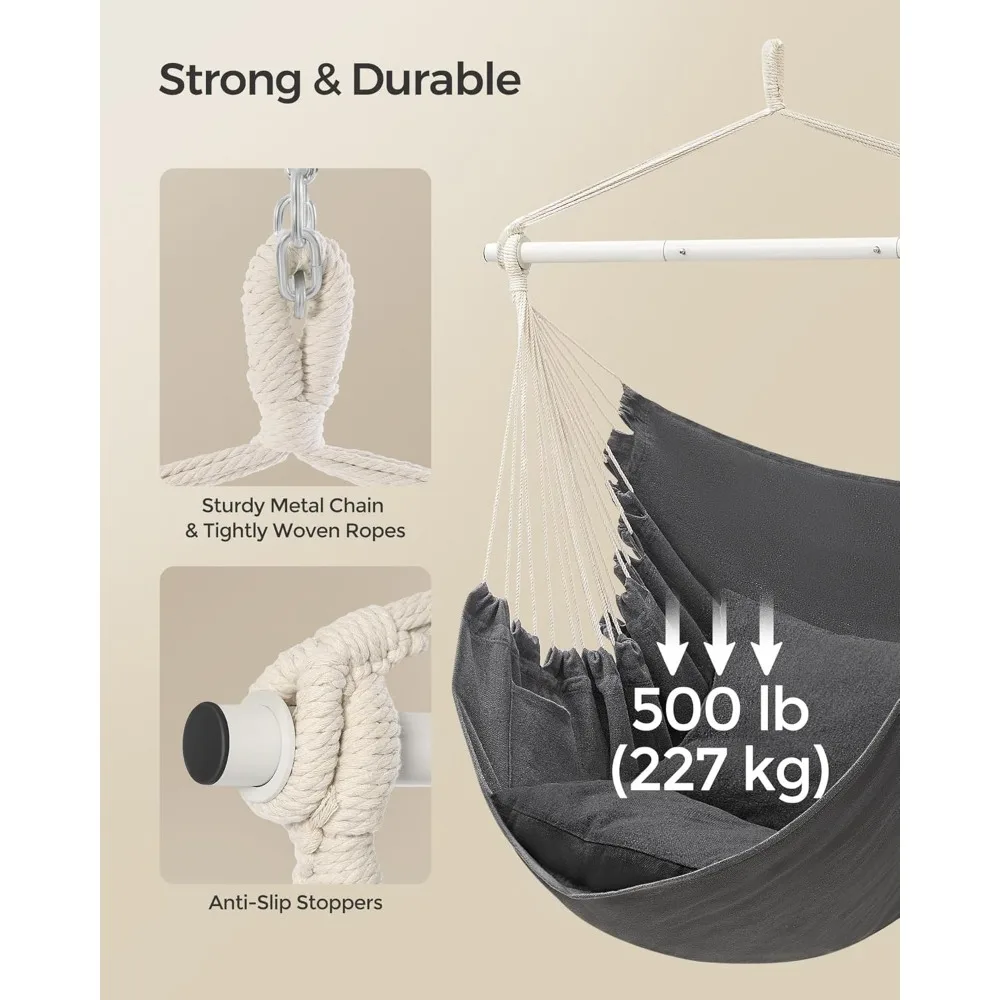
Style and Aesthetic Integration
Your hammock chair should complement your existing porch design:
Design Style Matching
– Modern: Clean lines, monochromatic fabrics, metal frames
– Traditional: Classic patterns, warm wood tones, detailed weaving
– Coastal: Blues and whites, rope elements, weathered finishes
– Bohemian: Macramé details, tassels, eclectic patterns, natural materials
– Farmhouse: Neutral tones, simple patterns, rustic elements
Color Selection Strategies
– Weather-resistant considerations (darker colors show less dirt)
– Coordination with existing furniture and decor
– Seasonal adaptability with accessories
– Visual weight in the overall space
Coordination Techniques
– Matching or complementary pillow fabrics
– Repeating material elements (wood, metal, rope)
– Consistent color palette across different pieces
– Balanced visual distribution in the space
Budget Considerations
Hammock chairs vary widely in price based on quality and features:
Price Range Overview
– Budget: $50-150 (basic models, fewer weather-resistant features)
– Mid-range: $150-300 (better materials, more comfort features)
– Premium: $300-600+ (exceptional durability, superior comfort, designer styles)
Value Assessment Factors
– Construction quality (double stitching, reinforced stress points)
– Material durability ratings
– Warranty coverage
– Brand reputation and customer service
Investment Priorities
– Prioritize structural components and mounting hardware for safety
– Weather resistance for longest lifespan
– Comfort features for chairs used frequently
– Consider long-term value over initial savings
Our Top Hammock Chair Recommendations for Covered Porches
Best Overall Hanging Hammock Chair for Covered Porches
Why It’s Ideal: This balanced design offers exceptional comfort, durability, and style for covered porches. The premium cotton-polyester blend fabric provides the perfect combination of softness and weather resistance.
Key Features & Specifications:
– Material: 60% cotton, 40% polyester with marine-grade hardware
– Dimensions: 30” width × 48” height (seating area)
– Weight Capacity: 330 pounds
– Installation Type: Ceiling hanging (hardware included)
– Special Features: Integrated side pocket, removable cushions, spreader bar design
Practical Experience:
The chair’s medium-firm support accommodates various body types while providing exceptional back alignment. Assembly takes approximately 15 minutes with basic tools. The fabric has shown minimal fading after extended use in partially exposed porch environments.
Best Use Case: Perfect for reading nooks on covered porches with standard 8-9 foot ceilings. The neutral design complements most outdoor furniture styles.
Pros:
– Excellent balance of comfort and durability
– Easy entry and exit compared to traditional hammocks
– Machine-washable cushion covers
– Minimal stretching over time
Cons:
– Requires secure ceiling joist for mounting
– Spreader bar can make storage more challenging
Value Assessment: Mid-to-high price range but justified by the premium materials and construction quality that ensure years of use.
Best Premium Option with Superior Comfort
Why It’s Ideal: This luxury hammock chair elevates the porch experience with exceptional padding, premium materials, and thoughtful design details that create a true retreat feeling.
Key Features & Specifications:
– Material: Sunbrella® fabric with marine-grade stainless hardware
– Dimensions: 36” width × 54” height (seating area)
– Weight Capacity: 400 pounds
– Installation Type: Hanging with included spring and swivel
– Special Features: 4” thick memory foam cushioning, adjustable headrest, cup holder
Practical Experience:
The deep cushioning creates a cloud-like seating experience that remains comfortable for hours. The fabric has shown zero fading after two years in partially exposed conditions. The swivel feature allows for 360° rotation, adding an extra dimension to the relaxation experience.
Best Use Case: Ideal for creating a primary relaxation space on larger covered porches where comfort is the top priority.
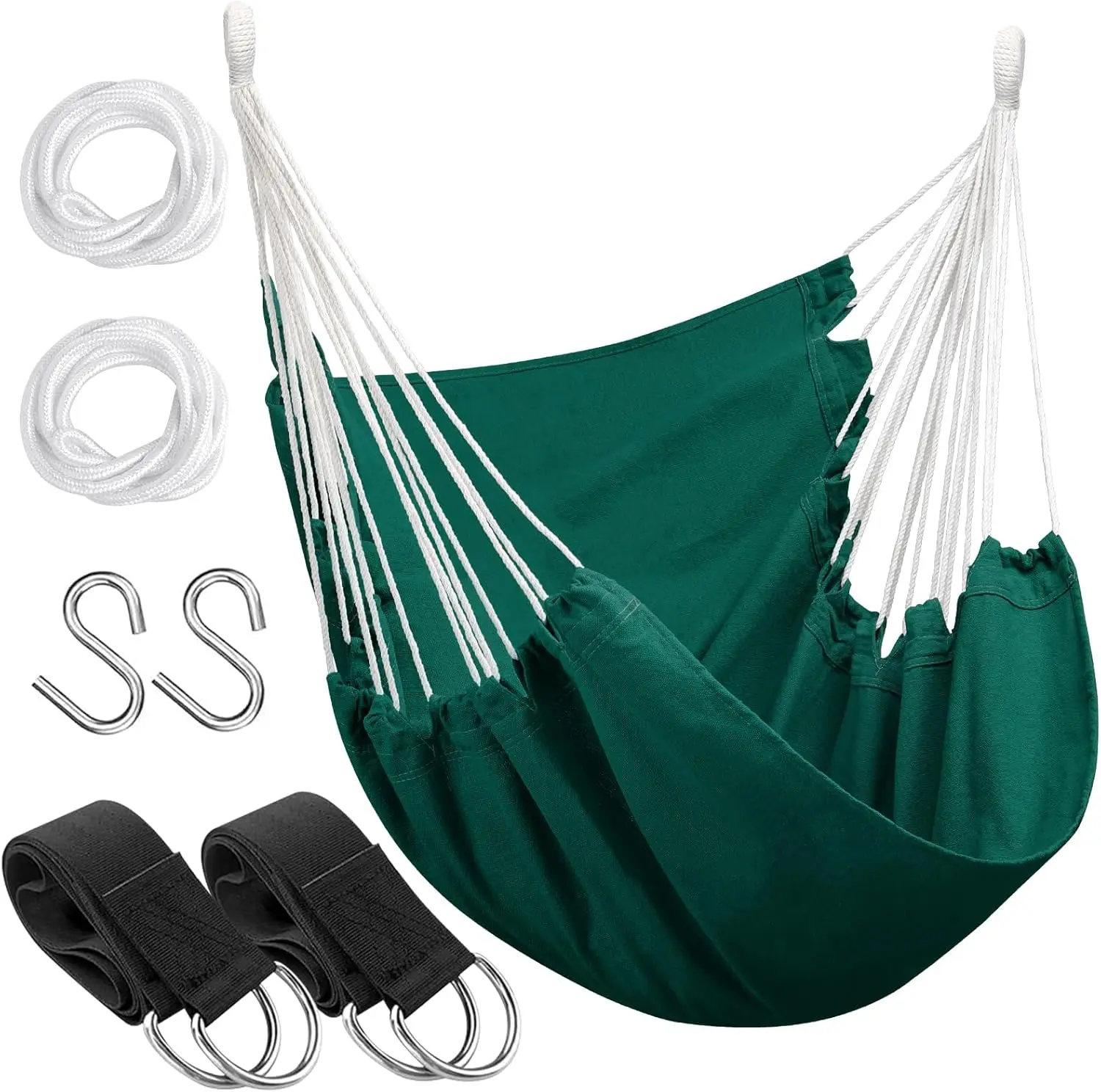
Pros:
– Exceptional comfort for extended sitting
– Superior weather resistance
– Elegant design that elevates porch aesthetics
– Outstanding durability in all components
Cons:
– Premium price point
– Larger size requires more clearance space
Value Assessment: High-end pricing but represents an investment in comfort and durability that will outlast multiple cheaper alternatives.
Best Budget-Friendly Hammock Chair
Why It’s Ideal: This affordable option delivers surprising comfort and style without compromising on essential features, making it perfect for those new to hammock chairs.
Key Features & Specifications:
– Material: Polyester canvas with powder-coated steel hardware
– Dimensions: 24” width × 40” height (seating area)
– Weight Capacity: 265 pounds
– Installation Type: Hanging (basic hardware included)
– Special Features: Two decorative pillows, compact foldable design
Practical Experience:
While simpler in construction than premium models, this chair provides comfortable support for average-sized adults. The polyester fabric dries quickly after humidity exposure and resists light staining. Perfect entry-level option that still delivers on the essential hammock chair experience.
Best Use Case: Ideal for occasional use, guest seating, or testing whether a hammock chair suits your lifestyle before investing in higher-end options.
Pros:
– Exceptional value for the price point
– Surprisingly durable construction
– Compact when folded for seasonal storage
– Attractive design belies the budget price
Cons:
– Less padding than premium models
– Somewhat limited color options
– Hardware may need upgrading for long-term use
Value Assessment: Excellent entry-level value that provides the core hammock chair experience at an accessible price point.
Dark Wood Hammock Sets, Porch Swing Chair Sets
$653.82 Select options This product has multiple variants. The options may be chosen on the product pageA-Frame Stand Hammock Sets, Swinging Hammock Chair Sets
$154.62 Select options This product has multiple variants. The options may be chosen on the product pageLight Wood Hammock Sets, Swinging Hammock Chair Sets
$1,359.35 Select options This product has multiple variants. The options may be chosen on the product pageClassic Wooden Stand Hammock Sets, Heavy Duty Hammock Sets
$1,061.68 Select options This product has multiple variants. The options may be chosen on the product pageHammock Sets with Canopy, Heavy Duty Hammock Sets
$286.31 Select options This product has multiple variants. The options may be chosen on the product pageFolding Hammock Sets, Quick Setup Hammock Sets
Price range: $305.52 through $583.27 Select options This product has multiple variants. The options may be chosen on the product page
Best Stand-Based Hammock Chair
Why It’s Ideal: This freestanding system eliminates installation concerns while providing exceptional stability and a premium seating experience for covered porches.
Key Features & Specifications:
– Material: Powder-coated steel stand with weather-resistant fabric chair
– Dimensions: 48” base diameter × 80” height
– Weight Capacity: 350 pounds
– Special Features: 360° swivel hook, tool-free assembly, adjustable height
Practical Experience:
The stable base design prevents tipping even with active movement. Assembly takes under 30 minutes without special tools. The chair hangs at an ideal ergonomic angle for comfortable sitting with good back support. The stand’s sleek design complements rather than overwhelms porch aesthetics.
Best Use Case: Perfect for rental properties or porches where ceiling mounting isn’t feasible. Also excellent for those who want flexibility to reposition their chair seasonally.
For more options that offer flexibility and stability, browse our deep seat chair hammock sets.
Pros:
– No installation or structural requirements
– Can be moved to different locations
– Exceptional stability even with active use
– High-quality construction throughout
Cons:
– Larger footprint than hanging models
– Somewhat limited swing radius
Value Assessment: Mid-range price representing good value considering the inclusion of both stand and chair in a cohesive system.
Most Weather-Resistant Option for Semi-Protected Porches
Why It’s Ideal: Specifically engineered for environments with partial weather exposure, this hammock chair combines comfort with exceptional durability for porches with less complete coverage.
Key Features & Specifications:
– Material: Solution-dyed olefin fabric with marine-grade stainless hardware
– Dimensions: 28” width × 46” height (seating area)
– Weight Capacity: 330 pounds
– Installation Type: Hanging with included quick-dry padding
– Special Features: UV-stabilized fabric, quick-dry foam, water-resistant storage pocket
Practical Experience:
Performance in semi-protected environments is exceptional—the chair dries within 30 minutes after light rain exposure and shows minimal fading even in areas with significant reflected UV light. The fabric texture remains comfortable against skin while being remarkably resistant to moisture issues.
Best Use Case: Ideal for covered porches with partial sun exposure or those prone to wind-driven rain. Perfect for coastal environments where salt air and humidity are concerns.
For similar durability in larger formats, see our heavy-duty hammock sets.
Pros:
– Superior weather resistance in challenging conditions
– Quick-drying properties prevent mildew issues
– Maintains comfort despite technical materials
– Fade-resistant even with UV exposure
Cons:
– Somewhat limited color palette
– Technical fabrics lack some of the softness of natural fibers
Value Assessment: Mid-to-high pricing justified by specialized materials that significantly extend the product lifespan in challenging environments.
Professional Installation Guide: Hanging Your Hammock Chair
Safety-First Approach
Before installing any hammock chair, safety must be your primary concern:
Weight Capacity Considerations
– Verify both chair capacity and mounting point strength
– Use hardware rated for at least 2× the maximum weight
– Consider dynamic weight (movement) not just static weight
– Always include a safety margin in your calculations
Structural Support Requirements
– Wooden ceiling joists: Minimum 2×6 inches
– Exposed beams: Minimum 4×4 inches
– Concrete ceilings: Requires specialized anchors and professional assessment
– Never mount to drywall, paneling, or decorative beams alone
Professional Consultation Scenarios
– Uncertainty about joist location or strength
– Concrete ceiling installation
– Weight capacity exceeding 300 pounds
– Historic homes with non-standard construction
Pre-Installation Planning
Proper preparation ensures a smooth, safe installation:
Essential Tools and Hardware
– Stud finder (electronic, with deep scan capability)
– Drill with appropriate bits for your ceiling material
– Wrench or socket set for tightening hardware
– Tape measure and pencil for marking
– Level to ensure proper alignment
– Eye bolt or mounting kit (minimum 3/8” diameter, 600 lb rating)
– Spring and swivel components (recommended for smoother swinging)
Locating Suitable Mounting Points
– Use stud finder to locate center of ceiling joist
– Mark joist location with pencil
– Verify joist location with small pilot hole
– Ensure minimum clearance in all directions (3-4 feet)
– Check for obstacles in swinging path
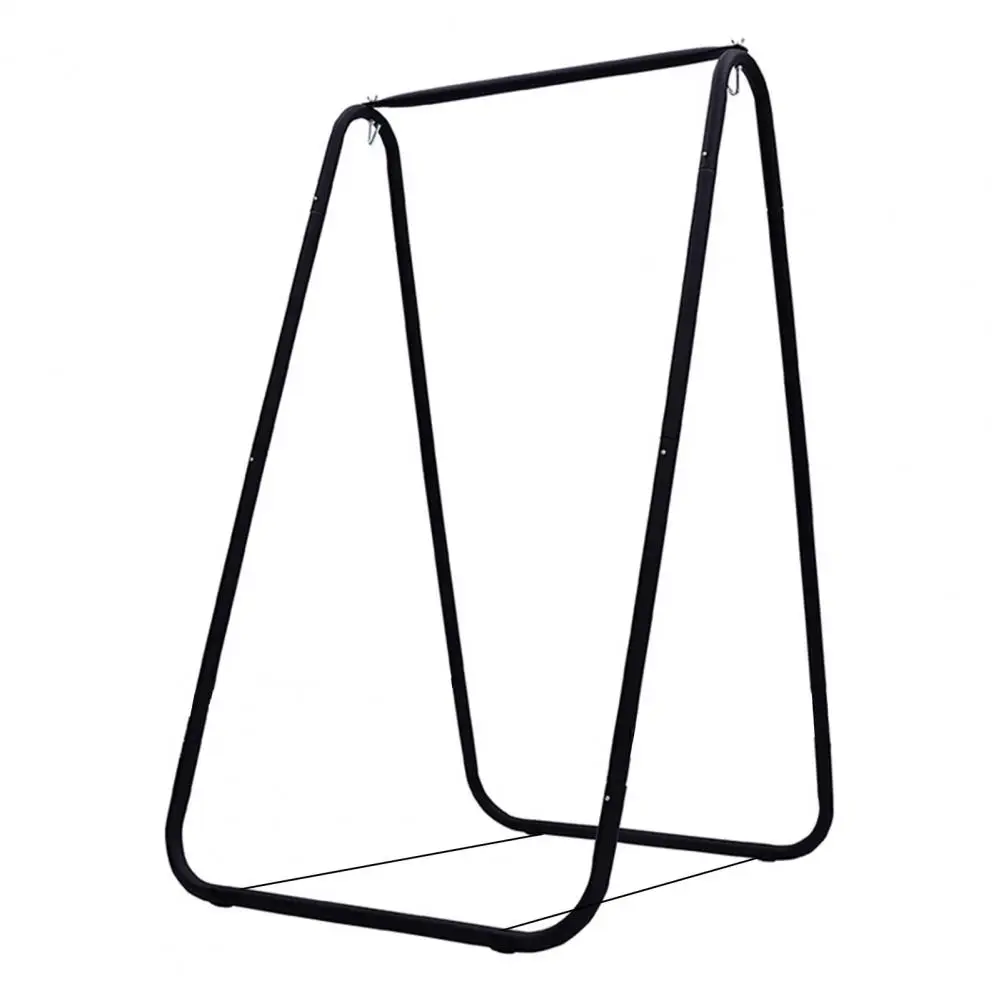
Step-by-Step Ceiling Installation Process
Follow these steps carefully for safe, secure mounting:
Identify Structural Support
– Use stud finder to locate center of ceiling joist
– Mark location with pencil
– Verify with small (1/16”) pilot hole
– Confirm solid wood with thin wire probe if neededPre-Drilling and Hardware Installation
– Drill pilot hole sized for your eye bolt (typically 3/16” – 1/4”)
– Insert eye bolt into pilot hole
– Tighten by hand first, then with wrench
– Ensure eye is aligned with desired swing directionInstalling Extension Hardware
– Attach spring to eye bolt (reduces shock load)
– Add swivel below spring (prevents rope twisting)
– Connect extension chain if needed for height adjustment
– Secure all connections with locking carabinersHanging the Chair
– Attach chair to mounting hardware
– Adjust height (sitting position should allow feet to touch ground)
– Check that all connections are fully closed and secured
– Verify chair hangs level and at appropriate heightSafety Testing
– Gradually apply weight to the chair
– Test with various sitting positions
– Listen for any unusual sounds from mounting hardware
– Inspect all connection points before full use
For complete installation details, see our guide on how to install porch hammock chairs.
Alternative Mounting Options
When traditional ceiling mounting isn’t feasible, consider these alternatives:
Exposed Beam Techniques
– Wrap-around straps for non-drilled installation
– Through-bolt installation for maximum security
– Decorative mounting plates for finished appearance
Specialized Hanging Kit Options
– Beam clamps for non-permanent installation
– Ceiling plate systems for distributing weight
– Extension systems for higher ceilings
Challenging Ceiling Solutions
– Toggle bolts for plaster ceilings (with caution and reduced weight)
– Concrete ceiling anchors (professional installation recommended)
– Reinforcement plates for thinner joists
For stand-based alternatives that eliminate installation concerns entirely, browse our A-frame stand hammock sets.
Stand Assembly Guidance
For stand-based hammock chairs:
Positioning for Maximum Stability
– Place on flat, level surface
– Position away from edges of porch
– Ensure all legs make full contact with floor
– Consider rubber feet for additional stability
Assembly Best Practices
– Follow manufacturer’s instructions precisely
– Tighten all connections securely
– Check alignment of all components
– Test stability before full weighting
Weight Distribution Considerations
– Center chair properly within stand
– Distribute user weight evenly when seated
– Be aware of maximum weight capacity
– Consider additional base weight for very active users
Styling Your Hammock Chair: Design Ideas for Covered Porches
Creating a Cohesive Porch Atmosphere
Your hammock chair should enhance your overall porch design:
Coordinating with Existing Furniture
– Echo design elements from other furniture pieces
– Match metal finishes (brushed nickel, bronze, matte black)
– Incorporate consistent wood tones across different pieces
– Use common design language throughout your space
Color Palette Strategies
– Choose chair colors that complement your home’s exterior
– Consider weather-resistant options that maintain appearance
– Use the 60-30-10 rule (60% dominant color, 30% secondary color, 10% accent color)
– Create continuity between indoor and outdoor spaces through color
Texture Layering
– Combine smooth and textured elements for visual interest
– Mix natural fibers with modern materials
– Add depth through contrasting weaves and patterns
– Include both soft and structured elements
For natural aesthetic options that blend beautifully with most porch designs, explore our wooden hammocks and stands.
Accessorizing Your Hammock Chair
The right accessories enhance both comfort and style:
Cushion and Pillow Selection
– Choose weather-resistant fabrics like Sunbrella or olefin
– Layer different sizes for both support and aesthetics
– Consider removable covers for seasonal changing or cleaning
– Coordinate colors while adding complementary accent hues
Throws and Blankets
– Add lightweight options for cool evenings
– Choose quick-drying materials for humid environments
– Select patterns that complement your overall design
– Consider texture as a design element
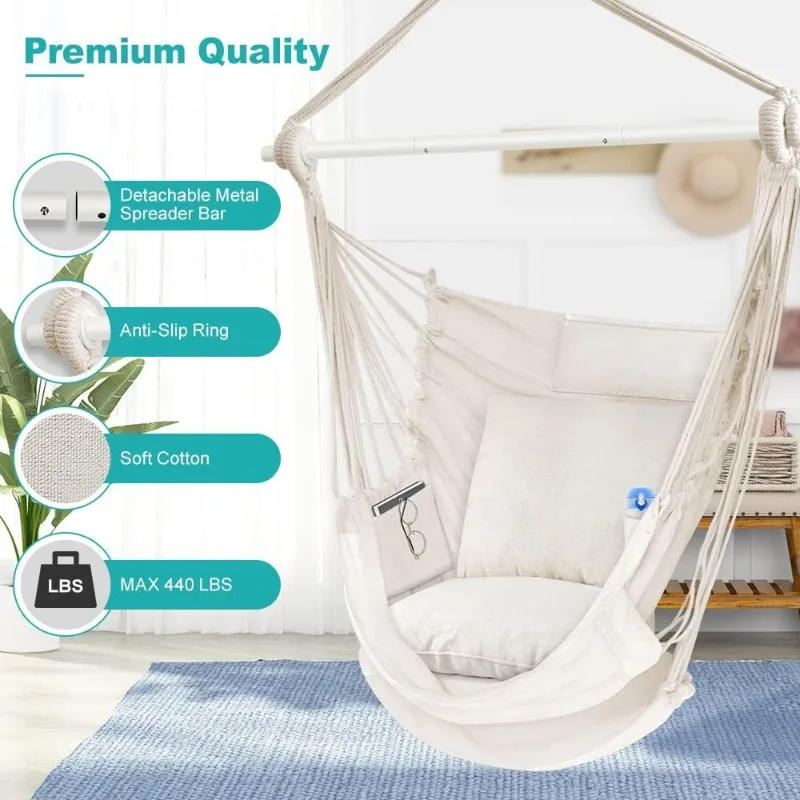
Weather-Appropriate Textiles
– Prioritize quick-drying, moisture-resistant fabrics
– Consider seasonal rotation of accessories
– Choose materials that resist fading and mildew
– Balance aesthetics with practical performance
Complementary Furniture Placement
Create functional groupings that enhance your hammock chair experience:
Side Table Options
– Height-appropriate small tables within arm’s reach
– Nesting tables for flexible space management
– Weather-resistant materials matching your overall aesthetic
– Consider C-tables that tuck under the chair when in use
Lighting Integration
– Floor lamps positioned for reading
– String lights for ambient atmosphere
– Solar lanterns for eco-friendly illumination
– Consider lighting that highlights your hammock chair as a focal point
Plant Positioning
– Frame your hammock area with potted plants
– Use hanging plants for vertical interest
– Choose species well-suited to your porch’s light conditions
– Consider fragrant varieties to enhance the sensory experience
For comprehensive design inspiration, visit our ultimate guide to swinging hammock chairs.
Seasonal Styling Changes
Keep your hammock chair area fresh and appropriate year-round:
Spring/Summer Styling
– Lighter, brighter colors
– Cooling fabric choices
– Added shade elements as needed
– Planters with seasonal blooms
Fall/Winter Adaptation
– Warmer color palettes
– Addition of outdoor-safe throw blankets
– Weather protection considerations
– Potential lighting additions for earlier sunsets
Holiday Integration
– Subtle seasonal decorations that don’t impede function
– Temporary pillow covers for holiday themes
– Coordinated lighting for seasonal ambiance
– Consider how your hammock chair can become part of seasonal traditions
Maintenance and Care for Long-Lasting Enjoyment
Regular Cleaning Protocols
Proper cleaning extends the life of your hammock chair:
Fabric-Specific Care
– Removable covers: Follow manufacturer’s washing instructions
– Fixed fabric: Spot clean with mild soap and soft brush
– Macramé/rope: Dust regularly, deep clean seasonally
– Frequency: Monthly light cleaning, seasonal deep cleaning
Appropriate Cleaning Agents
– Avoid bleach on colored fabrics
– Use fabric-specific cleaners for stubborn stains
– Consider diluted vinegar solution for mildew prevention
– Test any cleaner on an inconspicuous area first
Spot Cleaning Techniques
– Blot spills immediately, don’t rub
– Use clean white cloths for cleaning
– Work from outside of stain inward
– Allow to dry completely before using
Seasonal Maintenance Schedule
Stay ahead of potential issues with regular maintenance:
Spring Readiness
– Check all hardware for winter damage
– Tighten any loosened connections
– Deep clean after winter storage
– Apply fabric protector if appropriate
Summer Care
– Rinse salt and sunscreen residue regularly
– Check for UV damage or fading
– Ensure proper tension in hanging components
– Inspect for insect activity
Fall Preparation
– Clear debris from crevices
– Apply protective treatments if needed
– Check for wear points or stress areas
– Consider weather protection needs
Winter Protection
– Consider temporary removal if extremely exposed
– Use weather covers for stand-based models
– Ensure proper drainage to prevent ice damage
– Store removable cushions indoors
Understanding how to transition between seasons is important—our guide on indoor-outdoor hammock placement provides helpful strategies.
Hardware Inspection and Maintenance
Safety depends on well-maintained hardware:
Regular Inspection Points
– Check chains and S-hooks for deformation
– Examine springs for stretching or corrosion
– Verify carabiners fully close and lock
– Inspect rope or fabric at connection points for wear
Maintenance Tasks
– Tighten all connections quarterly
– Apply silicone lubricant to springs and swivels
– Replace any components showing significant wear
– Keep threaded components clean of debris
Signs Requiring Immediate Attention
– Visible rust or corrosion on any component
– Deformation of metal parts
– Fraying or unraveling of rope elements
– Cracking sounds during use
Extending Your Hammock Chair’s Lifespan
Simple practices significantly extend your chair’s useful life:
UV Protection Strategies
– Position to minimize direct sunlight when possible
– Consider UV-protective sprays for natural fibers
– Rotate chair orientation periodically to distribute exposure
– Be aware of reflected UV from light-colored walls or windows
Humidity Management
– Ensure adequate air circulation
– Allow to dry completely after rain or high humidity
– Consider portable dehumidifier in extremely damp climates
– Avoid covering with non-breathable materials
Weight Distribution Practices
– Enter and exit chair carefully without jarring
– Distribute weight evenly across the seating area
– Avoid exceeding recommended weight capacity
– Consider how children use the chair (jumping in, etc.)
Storage Recommendations
– Clean thoroughly before storage
– Store in dry, temperature-controlled environment
– Hang fabric components rather than folding when possible
– Use breathable covers rather than plastic
Addressing Common Hammock Chair Challenges on Covered Porches
Stability Issues and Solutions
What causes swinging hammock chairs to become unstable?
Instability usually stems from inadequate mounting hardware, improper installation, or structural limitations. Ensure your mounting point connects directly to structural wood, not just decorative beams or drywall. Using a spring and swivel combination can also reduce lateral stress that contributes to instability.
How can I fix a wobbling hammock chair stand?
First, verify the stand is on a completely level surface. Check that all connections are fully tightened and that no parts have become bent or damaged. For additional stability, some users place rubber non-slip pads under stand legs or add weight to the base (sandbags work well for this purpose).
My chair spins too much when I’m trying to relax. How can I control this?
Remove the swivel component if excessive spinning is an issue. Alternatively, add a guide rope from the bottom of the chair to a fixed point on the floor—this limits rotation while still allowing comfortable swinging motion.
Weather-Related Concerns
Can hammock chairs be left out during storms if on a covered porch?
While covered porches provide significant protection, intense wind-driven rain can still reach your chair. During severe weather, either temporarily remove the chair or cover it with a water-resistant furniture cover. Pay special attention to cushions, which can become waterlogged and take days to dry properly.
How do I manage humidity issues with my hammock chair?
In humid environments, opt for synthetic fabrics that resist mildew and dry quickly. After periods of high humidity, ensure your chair gets adequate airflow—consider a small portable fan if needed. Regularly inspect rope and fabric for early signs of mildew, addressing immediately with a vinegar solution (1:4 vinegar to water) for natural fibers or a specialized cleaner for synthetics.
Comfort Optimization
How can I eliminate pressure points in my hammock chair?
Add strategic cushioning where you feel pressure, particularly under thighs and lower back. Consider a small lumbar pillow for back support. For rope chairs, looser weaves generally provide better weight distribution than tight patterns. If pressure points persist, a chair with more even weight distribution might be better for your body type.
What’s the optimal hanging height for my hammock chair?
When seated, your feet should rest comfortably on the ground with knees slightly bent. Most adults find the ideal seat height is 16-18 inches from the floor, but this varies based on height and personal preference. Adjustable hanging chains make finding your perfect height much easier.
Noise Reduction
How do I stop my hanging hardware from squeaking?
Apply silicone-based lubricant to all moving metal parts, particularly springs and swivel components. Avoid WD-40 or oil-based lubricants that can attract dust and dirt. For persistent squeaks, consider replacing metal components with newer versions that have better tolerances.
My rope hammock chair makes noise when I move. Can this be fixed?
Natural fiber ropes often create noise as they rub against each other. A light application of beeswax to rope intersection points can reduce friction without compromising the material. For synthetic ropes, ensure proper tension—too loose can cause excessive movement and resulting noise.
Hammock Chairs for Special Situations: Beyond the Standard Covered Porch
Semi-Protected Porch Environments
Not all covered porches offer complete protection. For partially exposed areas:
– Choose synthetic fabrics with superior UV and moisture resistance
– Consider quick-remove hanging systems for rapid response to weather changes
– Use protective covers during off-periods
– Incorporate additional overhead protection like outdoor curtains on exposed sides
– Position the chair in the most protected area of your porch
Multi-Use Hammock Chair Solutions
Maximize versatility with chairs designed for various environments:
– Select chairs with simple dismounting systems for seasonal relocation
– Choose neutral colors and designs that work both indoors and out
– Invest in both ceiling mount and compatible stand for maximum flexibility
– Consider weight and foldability for chairs that will be moved frequently
For maximum flexibility, explore our portable hammocks and stands that can be easily relocated as needed.
Accessibility Considerations
Make hammock chairs more accessible for users with mobility challenges:
– Choose models with more structured entry points
– Install at optimal height for easier transfer
– Add support rails or handles near the chair location
– Consider swing chairs with more defined seating
– Use stands with stabilizing features for safer entry and exit
Small Space Solutions
Limited porch space doesn’t mean you can’t enjoy a hammock chair:
– Opt for corner-optimized designs that tuck neatly into unused spaces
– Choose chairs with smaller swing radius requirements
– Look for multi-functional pieces (storage in the base, etc.)
– Consider wall-mounted folding options that can be tucked away when not in use
Frequently Asked Questions About Hammock Chairs for Covered Porches
Is it safe to hang a hammock chair from any covered porch ceiling?
No, not all ceilings provide adequate support. Your mounting point must connect to a structural element like a ceiling joist or beam. Standard ceiling joists (2×6 or larger) are typically sufficient for hammock chairs with weight capacities up to 300 pounds. Never mount to just the decorative ceiling covering.
What’s the minimum height requirement for a hammock chair?
For comfortable use, you need a minimum ceiling height of 7.5 feet. This allows for the chair suspension system plus adequate head clearance when seated. Lower ceilings may work with specialized short-hanging chairs, but standard models require proper vertical space.
Can I install a hammock chair by myself?
Most hammock chair installations are DIY-friendly if you have basic tools and can locate ceiling joists. The most challenging part is often finding and verifying the structural support. If you’re uncomfortable with this process or need to mount to concrete, professional installation is recommended.
Are hammock chairs suitable for everyday use?
Quality hammock chairs are designed for regular use. Premium models with proper installation can serve as primary seating for many years. The key factors affecting longevity are material quality, proper installation, and appropriate maintenance.
How much space is needed around a hammock chair?
Allow at least 3 feet of clearance in all directions from the center of your hammock chair. This provides space for the natural swinging motion without hitting walls or furniture. Entry and exit require additional clearance, typically at least 2 feet on one side.
Can hammock chairs be left outside in winter on a covered porch?
In mild climates with truly covered porches, many hammock chairs can remain installed year-round. However, in regions with harsh winters, removing the chair or at minimum the fabric components and cushions is recommended. Freezing temperatures can damage fibers and make synthetic materials brittle.
Hammock Chairs vs. Alternative Seating for Your Covered Porch
When considering porch seating options, compare these alternatives to determine the best fit for your needs:
| Feature | Hammock Chairs | Traditional Porch Swings | Rocking Chairs | Standard Lounge Chairs |
|---|---|---|---|---|
| Space Required | 3-4 ft radius | 5-6 ft width, 3-4 ft depth | 3-4 ft with rocking space | 2-3 ft width, 3 ft depth |
| Seating Capacity | 1 person | 2-3 people | 1 person | 1 person |
| Motion Type | 360° swinging/rotation | Back-and-forth only | Rocking motion | Static |
| Installation | Ceiling mount or stand | Ceiling mount or stand | No installation | No installation |
| Comfort Factor | High (enveloping support) | Medium-High | Medium-High | Medium |
| Weather Resistance | Varies by material | Typically good | Excellent | Excellent |
| Price Range | $50-600+ | $150-1000+ | $100-500+ | $80-400+ |
| Visual Impact | High (focal point) | High (focal point) | Medium | Low-Medium |
When to Choose a Hammock Chair:
– When space is limited but you want seating with movement
– When creating a distinctive visual feature on your porch
– When seeking the therapeutic benefits of gentle swinging motion
– When you prefer enveloping, cocooning comfort
– When you want flexibility in placement (with stand models)
When to Consider Alternatives:
– When seating multiple people simultaneously is a priority
– When users have difficulty with the entry/exit of hammock chairs
– When very high weight capacity is required
– When structural limitations prevent secure hanging
– When a more formal or traditional aesthetic is desired
DIY Enhancement Projects for Your Hammock Chair
Custom Cushion Creation
Materials:
– 2 yards outdoor fabric (Sunbrella or similar)
– 2 inches thick high-density foam
– Outdoor thread
– Velcro or zipper closure
– Sewing machine or fabric glue
Basic Steps:
1. Measure your hammock chair’s seating area
2. Cut foam 1 inch larger than seating area on all sides
3. Create pattern for cushion cover with 1/2 inch seam allowance
4. Sew three sides, insert foam, close with Velcro or zipper
5. Add ties or straps to secure to your chair
No-Sew Alternative: Use outdoor fabric glue and Velcro strips to create a simple envelope-style cushion cover.
Decorative Macramé Additions
Materials:
– 100-200 feet of 4mm cotton or synthetic cord
– Wooden beads (optional)
– Scissors
– Measuring tape
Basic Steps:
1. Create a simple fringe by folding cords in half and attaching to the edge of your hammock chair
2. Learn basic macramé knots online (square knot, spiral knot)
3. Create decorative patterns along the edges of your chair
4. Add wooden beads at the end of cords for weight and decoration
5. Trim ends evenly for a finished look
Skill Level: Beginner to intermediate, depending on complexity of design
Lighting Integration
Materials:
– Battery-operated LED string lights
– Zip ties or thread
– Command hooks (for removable installation)
Basic Steps:
1. Choose waterproof battery-operated lights for outdoor use
2. Weave lights through chair fabric or rope structure
3. Secure with small zip ties or thread
4. Hide battery pack in fabric pocket or attach to underside
5. Install on/off switch in accessible location
Safety Considerations: Ensure all electrical components are rated for outdoor/damp locations. Keep battery packs protected from direct moisture.
Storage Solutions
Materials:
– 1/2 yard outdoor fabric
– Outdoor thread
– Velcro or snaps
– Scissors and pins
Basic Steps:
1. Measure and cut fabric for simple pocket design
2. Fold and hem edges
3. Attach to side or underside of chair with strong stitching
4. Add closure if desired
5. Reinforce stress points with extra stitching
Size Recommendations: Create pockets sized for specific items—book pocket (8”×10”), phone pocket (4”×6”), drink holder (4” diameter circle with elastic top)
About the Outside Luxe Difference
Our Testing Process
At Outside Luxe, we believe relaxation products deserve rigorous evaluation. Our hammock chairs undergo comprehensive testing that goes beyond basic functionality:
Our comfort assessment includes multiple body types and sitting positions to ensure universal appeal. Durability testing involves repeated loading and movement simulation equivalent to years of typical use. Weather exposure testing includes both controlled humidity chambers and real-world outdoor placement in various climate conditions.
We specifically evaluate aspects often overlooked by other retailers: fabric tension consistency over time, color fastness under UV exposure, hardware performance after repeated use, and noise development as components age.
Selection Criteria
Our hammock chairs must meet exacting standards to earn a place in our collection:
Materials must exceed industry averages for longevity and performance. Construction quality is verified through inspection of stitching patterns, hardware integration, and stress point reinforcement. Every chair design undergoes weight testing at 125% of its stated capacity to ensure a proper safety margin.
We prioritize designs that balance aesthetic appeal with practical functionality—beautiful chairs that also deliver exceptional comfort and durability.
Quality Commitment
Our relationship with manufacturers goes beyond typical retail arrangements. We maintain direct communication with production facilities, provide specific quality requirements, and reject products that don’t meet our standards.
Customer feedback directly influences our product development cycle. When issues are identified, we address them immediately through design refinements or, when necessary, by discontinuing products that don’t perform to our expectations.
This commitment to quality ensures that every hammock chair we offer represents the perfect intersection of comfort, durability, and style—creating outdoor living experiences that truly enhance your daily life.

